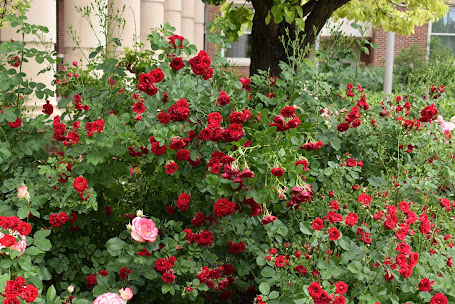Posted by: Dr. Jim Klett, Department of Horticulture and Landscape Architecture, Colorado State University
In 2021, Colorado State University continued its three year herbaceous perennial trial and chose eight perennials as the “Top Performers” from 126 that were planted in 2019. To become a CSU ‘Top Performer’ it has to have great survival percentages after two winters and three growing seasons and scored excellent throughout the three growing seasons. A sub-committee if the CSU Annual Trial Garden Advisory Committee evaluated twelve of the top performing perennials in November of 2021 by examining photos of these plants taken every two weeks during the three year growing seasons. A majority favorable vote from the committee is needed for a perennial to become a CSU ‘Top Performer’.
Achillea
‘Firefly Sunshine’
(Achillea
x hybrida) from Walters Gardens, Inc. /Proven Winners®
Vibrant yellow flowers provided a lot of color and with a long-lasting bloom. Dark green foliage also made the flower color stand out. It had superior qualities with a more compact growth habit that did not lodge despite overhead watering and had excellent winter survival. It was also noted that it did not spread around the garden which is a definite plus.
Brunnera
ALCHEMY™ Silver
(Brunnera
macrophylla) from Terra Nova Nurseries
This great plant can brighten up a shady area with a constant display of beautiful silver foliage. Plants are vigorous and are covered by a delicate cloud of light blue flowers from about May into June. Leaves are relatively thick and stands up well with strong stems to create a very attractive and uniform growth habit.
Eupatorium
Euphoria™ Ruby
(Eupatorium purpureum 'FLOREUPRE1’PP31,668) from Darwin Perennials®
Shorter and more compact than the species, this is a nice medium size plant for the modern landscape. This was a unanimous choice for the “Top Performer” award with dependable light ruby/lilac-colored flowers that combines well with dark leaves and stems. It was noted to be an excellent pollinator plant.
Perovskia
CrazyBlue
(Perovskia
atriplicifolia 'CrazyBlue' PP #25,639) from Darwin Perennials®
Plants were noted to have superior flowering and growth habit. The flowers have a long lasting bloom period and the violet-blue flowers last longer than other Perovskia. Uniform plants had interlacing branching and sturdy stems that kept it from lodging and maintained an attractive appearance all season. It is a mid-sized plant about 3-4 feet in height.
Rosa
Sunbeam Veranda®
(Rosa
x ‘ Korfloci52’ PP23,314) from Star® Roses and Plants
Glossy, dark green foliage made the bright yellow flower color even more stunning. Blooming started in June and lasted well into September. The compact size makes this a great choice for smaller gardens spaces. Plants had excellent winter hardiness.
Rosa
Cherry Frost™
(Rosa
x ‘Overedclimb’PP31,286) from Star® Roses and Plants
Sedum Prima Angelina
(Sedum rupestre)
from Darwin Perennials®
Great neon yellow foliage makes this an excellent foliage plant in the summer and it also is quite showy in the winter with a nice shade of red. The spreading growth habit is very uniform and a great choice with rock gardens or combined with other Sedums for additional color contrast. Prima Angelina is superior to the straight Angelina with better branching and growth habit while also being less brittle.
Veronica Moody Blues® Mauve Improved
(Veronica spicata) from Darwin Perennials®
Impressive vibrant, mauve colored blooms covered the plants at peak and repeated later in the season. Well branched plants were compact and very uniform with 100% winter survival. It has the added bonus of being a good bloomer the first year in the garden.

















Beautiful! That Perovskia has an unusually upright habit that doesn’t quite show up in the photo. It really makes it different than most Perovskias.
ReplyDeleteDoes this Perovskia spread rampantly? I've had one that did - although it's been a while and I don't have any record of the variety.
ReplyDeleteIt didn’t spread in three years in the CSU trial garden to my knowledge. But then the gardeners would pull up strays to keep it from going into the next perennial being trialed. It wasn’t something they mentioned though so I believe it spreads less than some. Some are aggressive!
ReplyDelete